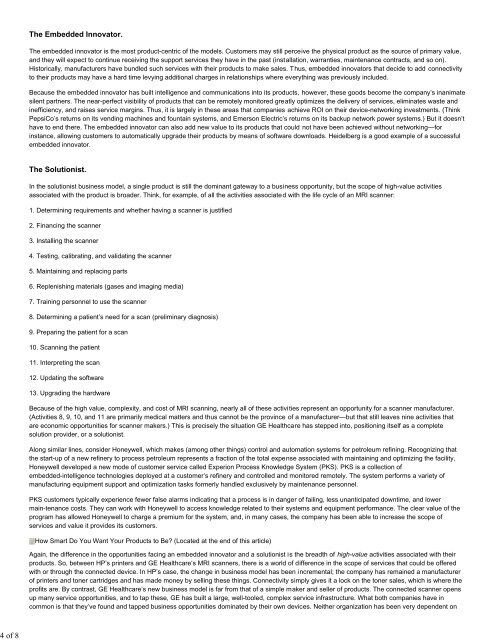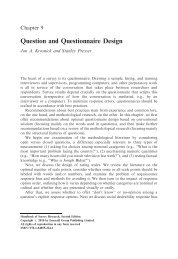Four Strategies for the Age of Smart Services - Courses
Four Strategies for the Age of Smart Services - Courses
Four Strategies for the Age of Smart Services - Courses
Create successful ePaper yourself
Turn your PDF publications into a flip-book with our unique Google optimized e-Paper software.
4 <strong>of</strong> 8<br />
The Embedded Innovator.<br />
The embedded innovator is <strong>the</strong> most product-centric <strong>of</strong> <strong>the</strong> models. Customers may still perceive <strong>the</strong> physical product as <strong>the</strong> source <strong>of</strong> primary value,<br />
and <strong>the</strong>y will expect to continue receiving <strong>the</strong> support services <strong>the</strong>y have in <strong>the</strong> past (installation, warranties, maintenance contracts, and so on).<br />
Historically, manufacturers have bundled such services with <strong>the</strong>ir products to make sales. Thus, embedded innovators that decide to add connectivity<br />
to <strong>the</strong>ir products may have a hard time levying additional charges in relationships where everything was previously included.<br />
Because <strong>the</strong> embedded innovator has built intelligence and communications into its products, however, <strong>the</strong>se goods become <strong>the</strong> company’s inanimate<br />
silent partners. The near-perfect visibility <strong>of</strong> products that can be remotely monitored greatly optimizes <strong>the</strong> delivery <strong>of</strong> services, eliminates waste and<br />
inefficiency, and raises service margins. Thus, it is largely in <strong>the</strong>se areas that companies achieve ROI on <strong>the</strong>ir device-networking investments. (Think<br />
PepsiCo’s returns on its vending machines and fountain systems, and Emerson Electric’s returns on its backup network power systems.) But it doesn’t<br />
have to end <strong>the</strong>re. The embedded innovator can also add new value to its products that could not have been achieved without networking—<strong>for</strong><br />
instance, allowing customers to automatically upgrade <strong>the</strong>ir products by means <strong>of</strong> s<strong>of</strong>tware downloads. Heidelberg is a good example <strong>of</strong> a successful<br />
embedded innovator.<br />
The Solutionist.<br />
In <strong>the</strong> solutionist business model, a single product is still <strong>the</strong> dominant gateway to a business opportunity, but <strong>the</strong> scope <strong>of</strong> high-value activities<br />
associated with <strong>the</strong> product is broader. Think, <strong>for</strong> example, <strong>of</strong> all <strong>the</strong> activities associated with <strong>the</strong> life cycle <strong>of</strong> an MRI scanner:<br />
1. Determining requirements and whe<strong>the</strong>r having a scanner is justified<br />
2. Financing <strong>the</strong> scanner<br />
3. Installing <strong>the</strong> scanner<br />
4. Testing, calibrating, and validating <strong>the</strong> scanner<br />
5. Maintaining and replacing parts<br />
6. Replenishing materials (gases and imaging media)<br />
7. Training personnel to use <strong>the</strong> scanner<br />
8. Determining a patient’s need <strong>for</strong> a scan (preliminary diagnosis)<br />
9. Preparing <strong>the</strong> patient <strong>for</strong> a scan<br />
10. Scanning <strong>the</strong> patient<br />
11. Interpreting <strong>the</strong> scan<br />
12. Updating <strong>the</strong> s<strong>of</strong>tware<br />
13. Upgrading <strong>the</strong> hardware<br />
Because <strong>of</strong> <strong>the</strong> high value, complexity, and cost <strong>of</strong> MRI scanning, nearly all <strong>of</strong> <strong>the</strong>se activities represent an opportunity <strong>for</strong> a scanner manufacturer.<br />
(Activities 8, 9, 10, and 11 are primarily medical matters and thus cannot be <strong>the</strong> province <strong>of</strong> a manufacturer—but that still leaves nine activities that<br />
are economic opportunities <strong>for</strong> scanner makers.) This is precisely <strong>the</strong> situation GE Healthcare has stepped into, positioning itself as a complete<br />
solution provider, or a solutionist.<br />
Along similar lines, consider Honeywell, which makes (among o<strong>the</strong>r things) control and automation systems <strong>for</strong> petroleum refining. Recognizing that<br />
<strong>the</strong> start-up <strong>of</strong> a new refinery to process petroleum represents a fraction <strong>of</strong> <strong>the</strong> total expense associated with maintaining and optimizing <strong>the</strong> facility,<br />
Honeywell developed a new mode <strong>of</strong> customer service called Experion Process Knowledge System (PKS). PKS is a collection <strong>of</strong><br />
embedded-intelligence technologies deployed at a customer’s refinery and controlled and monitored remotely. The system per<strong>for</strong>ms a variety <strong>of</strong><br />
manufacturing equipment support and optimization tasks <strong>for</strong>merly handled exclusively by maintenance personnel.<br />
PKS customers typically experience fewer false alarms indicating that a process is in danger <strong>of</strong> failing, less unanticipated downtime, and lower<br />
main-tenance costs. They can work with Honeywell to access knowledge related to <strong>the</strong>ir systems and equipment per<strong>for</strong>mance. The clear value <strong>of</strong> <strong>the</strong><br />
program has allowed Honeywell to charge a premium <strong>for</strong> <strong>the</strong> system, and, in many cases, <strong>the</strong> company has been able to increase <strong>the</strong> scope <strong>of</strong><br />
services and value it provides its customers.<br />
How <strong>Smart</strong> Do You Want Your Products to Be (Located at <strong>the</strong> end <strong>of</strong> this article)<br />
Again, <strong>the</strong> difference in <strong>the</strong> opportunities facing an embedded innovator and a solutionist is <strong>the</strong> breadth <strong>of</strong> high-value activities associated with <strong>the</strong>ir<br />
products. So, between HP’s printers and GE Healthcare‘s MRI scanners, <strong>the</strong>re is a world <strong>of</strong> difference in <strong>the</strong> scope <strong>of</strong> services that could be <strong>of</strong>fered<br />
with or through <strong>the</strong> connected device. In HP’s case, <strong>the</strong> change in business model has been incremental; <strong>the</strong> company has remained a manufacturer<br />
<strong>of</strong> printers and toner cartridges and has made money by selling <strong>the</strong>se things. Connectivity simply gives it a lock on <strong>the</strong> toner sales, which is where <strong>the</strong><br />
pr<strong>of</strong>its are. By contrast, GE Healthcare’s new business model is far from that <strong>of</strong> a simple maker and seller <strong>of</strong> products. The connected scanner opens<br />
up many service opportunities, and to tap <strong>the</strong>se, GE has built a large, well-tooled, complex service infrastructure. What both companies have in<br />
common is that <strong>the</strong>y’ve found and tapped business opportunities dominated by <strong>the</strong>ir own devices. Nei<strong>the</strong>r organization has been very dependent on
















